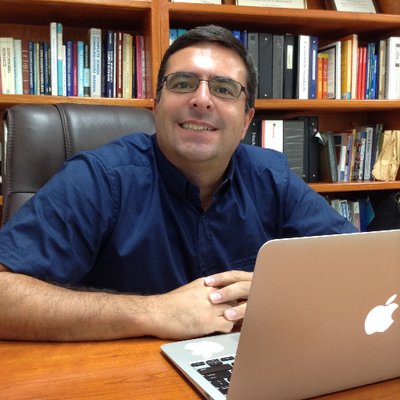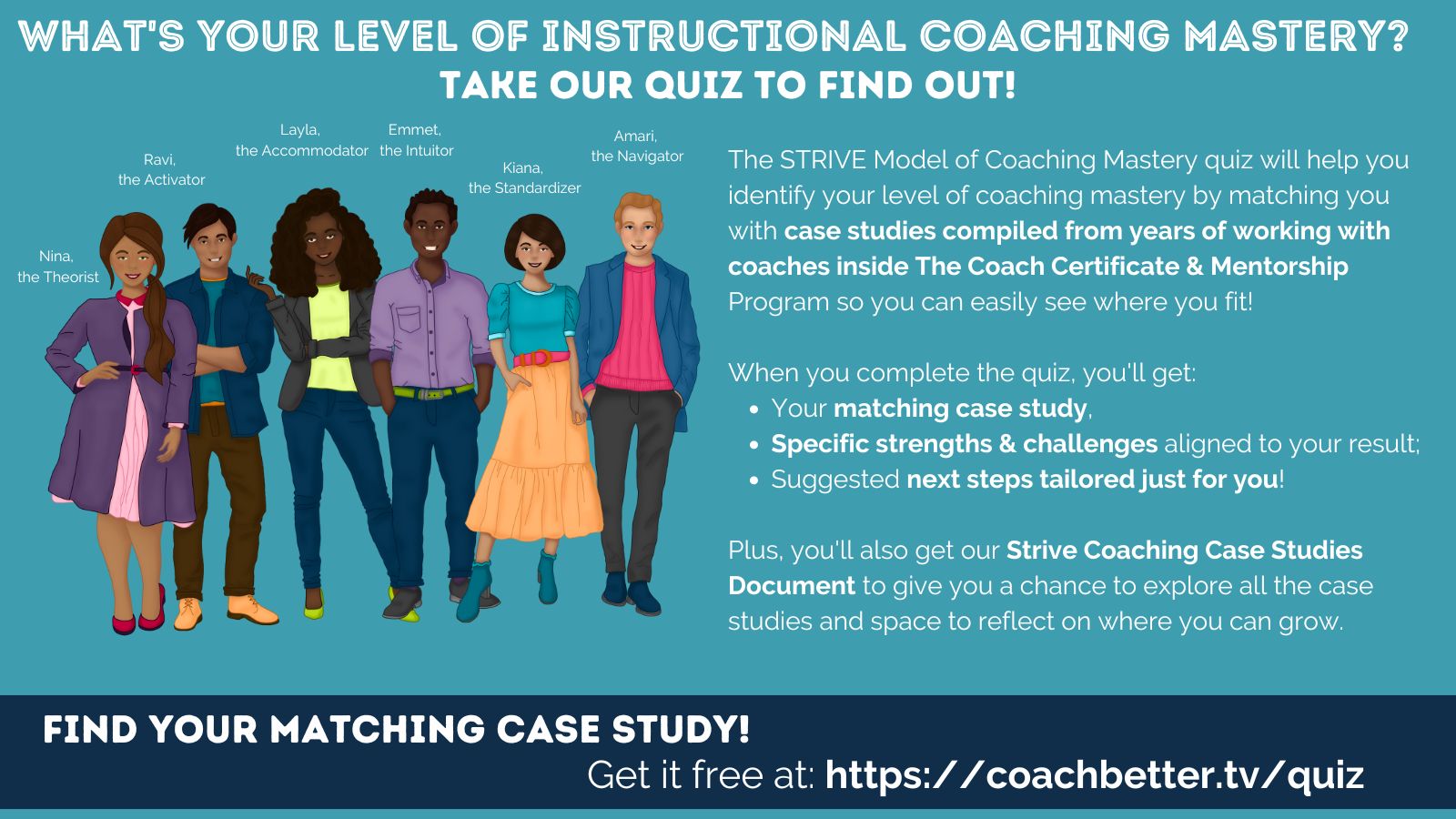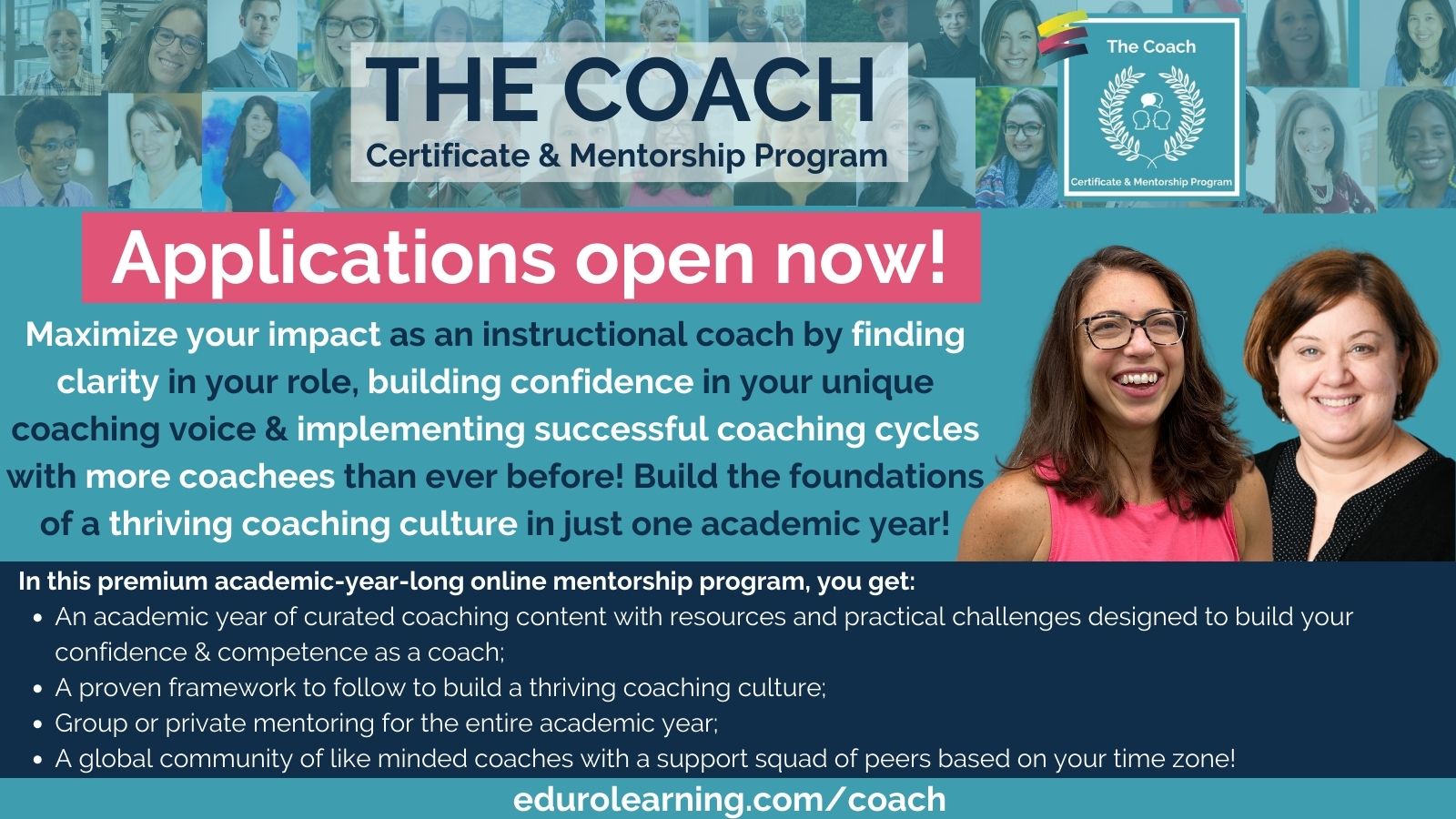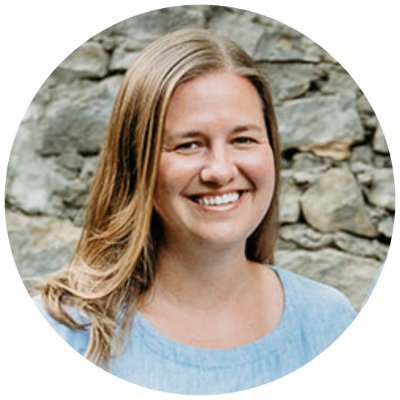It’s almost been a year that we’ve been remote learning and things are still changing, we’re still learning and encountering new surprises during this pandemic. This #coachbetter episode connects us back to our episodes from the spring – even though we’ve been in it for a while, we’re still constantly preparing to go remote, and this highlights the interplay between remote and F2F learning, particularly in our coaching practice. We have five of our superstar coaches from the podcast: Amy, Tim, Diana, Ben, and Will, so you get a wide range of perspectives and experiences! Since many of the schools we were in are back to face-to-face instruction, we also wanted to highlight the transition back to on-site school after an extended period of remote learning. We talk about what worked and what didn’t during remote learning, as well as the experiences coming back to in-person learning this academic year!
Subscribe to #coachbetter via your favorite Podcast Player!
Featured Guests


Bonus! Watch the Spotlight Version on YouTube!
Show Notes
What was the return to school like? How are your teachers coping? How are you supporting them?
Amy: Went into online learning with little to no notice. Feb – June. We ended last year, thinking we would come back full time. 3rd wave in June. Schools closed in July. Started virtual learning at the beginning of the year. First six weeks of the year was intense triage again.
Most of my time was spent in IT support, setting up platforms and structures, and a lot of parent communication. Lots of things that we wouldn’t normally do until many weeks into the school year, we were doing very early.
Ben: Started the year in person, but due to mandatory government quarantine, there were a number of parents, students, teachers unable to enter the school in person. Prioritized in-person learning, but still provided online learning. Set an end timeline for that online support.
Learned it was too difficult to be spread too thin with too many different groups of individuals.
People forgot how tiring it is to be in school.
Diana: New job in the US. working with ESOL students. Start of the year has been chaotic because school districts weren’t sure where they would be at the beginning of the year. Managing choice between students choosing online or f2f.
Tim: Second wave hit Korea, very serious very fast. Beginning of the year was really tough with no routines established as compared to starting online mid-year.
Will: came back after the holidays in the spring, in cohorts with some limitations. Biggest takeaway was getting used to being back in the school routine and all the new safety routines.
Ben: Contingency plans: school doesn’t stop, it just keeps rolling.
What worked as a coach? What would you do differently?
Diana: Lots of tech support. Understanding teachers’ needs, getting them set up in situations that made them feel comfortable in the new setting. The shock from the spring has passed.
Amy: Quote: “Teachers have been so consumed by the urgent that they’ve not been able to focus on the important.” 99% of my time was consumed by urgent requests. Sending devices home – being an advocate for student learning. Easing back into focusing on what’s important. I developed relationships with my 80 faculty in my division way faster and deeper than I would have in a normal year, part of it was triage, but being there, being calm, being patient and being responsive made a lot of relationships grow really quickly.
This year I can see how relationships are going to start to grow in different ways. In the spring I really supported teachers, on call 24/7. This year the teachers started with a lot more confidence and knowledge and skill, so I didn’t need to do as much urgent triage on teachers as I did with parents. 220 new 3rd graders. Families are feeling anxious. Part of all the parent orientation sessions, support of admin and accessibility to parents was really valuable.
Tim: Realized I needed to be a really strong advocate for work – life balance. Take your foot off the accelerator, all those initiatives are on hold now, until teachers feel confident and comfortable in this learning environment.
Will: Importance of getting feedback during all stages to allow you to iterate. Providing structures to teams (when things have to go out), but freedom within that. Bare bones and then allow teams to customize. As the spotlight turned away from tech skills, trying to do the heavy lifting for teachers and then refocus discussion back on student learning.
Ben: honed in on providing structures. Within the structure, people could be professional. Help create the structures based on what you know the needs are from everyone and then communicate that over and over again. You have to communicate clearly. You have to let things sit for a while, you can’t change things too often, so you get an implementation dip. Communicating what the success was, and then communicating the progress towards that place.
Diana: Amplify. We have the bigger picture in working with leadership so as coaches we often end up being the mediator / go-between. To help them see the bigger picture. Opportunities to amplify.
What’s YOUR level of coaching mastery?
All coaches go through various stages of coaching mastery. Once you identify where you’re at, you can begin to build the skills needed to move to the next stage.
This quiz is based on real-life case studies compiled from years of working with coaches inside The Coach Certificate & Mentorship Program!
When you receive your results, you’ll also get your matching case study from the STRIVE Case Studies to see where you fit in the stages of coaching mastery.
Ready to tackle your challenges and move on to the next level in YOUR coaching practice?

The STRIVE Model of Coaching Mastery quiz will help you identify your level of coaching mastery by matching you with case studies compiled from years of working with coaches inside The Coach Certificate & Mentorship Program so you can easily see where you fit!
When you complete the quiz, you’ll get:
- Your matching case study,
- Specific strengths & challenges aligned to your result;
- Suggested next steps for each stage;
Plus the Case Study Document includes:
- Case studies leveled by coaching mastery;
- A framework to identify essential stages of professional growth & key areas to focus on in your professional learning;
- Alignment with the THRIVE Model for a Successful Coaching Culture;
- Space for you to reflect & prioritize so you can take action immediately!
You’ll go straight to the Quiz, and get the Case Study Document via email.
Show Notes continued…
What were your communication / support strategies?
Amy talked about What’s App
Will: since returning, the really important thing that everyone is aware of is the importance of communication flows in school. Instead of communication overload, we have centralized faculty communication for a weekly newsletter, making a single point of communication. When we returned it was daily, but centralized. Pulling in some central systems for communication.
Diana: communication has to be more intentional now, can’t just pop in. Being in on meetings just to know what’s going on and be present and have my face there. Being intentional in planning and reaching out to people. Having a routine about when you reach out to people. Being intentional about turning notifications off at certain times of the day.
Will: Parking my own ego to the side. Doing the heavy lifting wasn’t always much appreciated work, but realizing that was there for the moment. Look for the time to rebuild those relationships by being present. I used to think that was kind of artificial. If I wasn’t adding value to the learning conversation, I could do background work and get that to them which proved to be more valuable. Now that we’re back at school I see how much people have appreciated it. Drop-in on classes now and it’s so much more appreciated.
Amy: Weekly tech tips, figuring out the frequency. Gauging the ebb and flow of the needs. That’s when I started realizing as a coach that when I get 20 emails about the same topics, I could send out an email with a screencast. If I could send out an email in advance, they were less likely to get stuck. It was a win-win. Shifting tech tip newsletter into a coaching corner newsletter. Transition communication so it’s not an additional newsletter. During this time I was reminded how nice it is to get a personal note (so many things are automated). Sent out a survey with 3 questions: What’s Happening? What’s going well? What are you hoping to start? How can I help? When teachers fill it in, they get a personalized follow-up email. Share it with a team every other week, if I haven’t had specific touch points with the team. They know that the reply is going to go through all 3 of those things. How important it is to feel seen and heard.
Diana: What are the needs and how are we adapting. We’re constantly adapting, getting feedback, reflecting, building relationships and making adjustments along the way. This experience has just amplified those experiences. The role of the coach to support those needs, and take our personal ego out of it, now we’re having those deeper more meaningful conversations
Level Up Your Coaching with The Coach!
If you are ready to dive deep into your coaching practice, to help you #coachbetter and build a thriving coaching culture in your school, please join us for our next cohort of The Coach!
Wherever you are in building a coaching culture in your school, The Coach will give you the strategies, skills and tools you need to make coaching a success and will empower you to confidently apply instructional coaching strategies in any situation – from building a coaching program, to having coaching conversations, to being a leader in your school community. We facilitate only one cohort each academic year so we can offer individualized support for each participant.
Coaches of all levels are welcome: you’ll start the program with a self-assessment to determine exactly what the next steps are for you!









Recent Comments